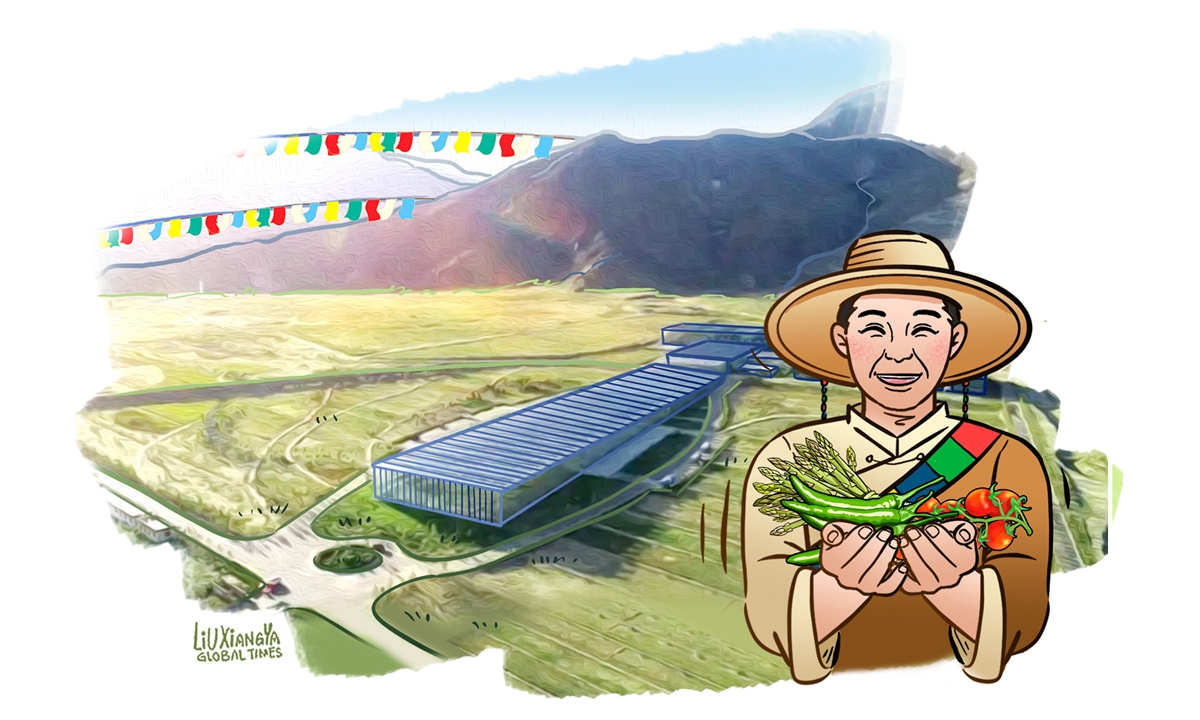
Illustration: Liu Xiangya/GT
This year marks the 30th anniversary of the country's implementation of paired-up assistance in Southwest China's Xizang Autonomous Region. The coordinated support for Xizang was a major strategic decision by the central government that has had a profound impact and made notable contributions to poverty alleviation efforts in the region.
Stepping into the homes of families lifted out of poverty, one can truly feel the changes that have occurred over the years.
In one home, the spacious and bright living room is decorated in a Tibetan style. The coal stove once used for cooking is now merely a decorative piece, as its function has long been replaced by a propane stove.
In the winter, the family gathers around the stove, with a pot of butter tea and some warm nuts to enjoy their leisure time. The tidy kitchen is equipped with various kitchen appliances. Speaking about their current life, Pasang, a member of the household, can't help but marvel at the changes.
In the past, they lived in adobe houses that were drafty in the winter and leaky in the summer. Lacking electricity, they relied on candles or kerosene lamps for light at night, which provided only dim illumination. The absence of running water made drinking and using water very inconvenient. Farming income was limited, and access to medical care was not guaranteed.
Nowadays, Pasang runs a small supermarket, and his son attends an elementary school nearby. The 15-year publicly-funded school education system has enabled children in Xizang to enjoy free education from kindergarten to high school, greatly alleviating the financial burden on families.
By the end of 2013, all 74 counties (districts) in Xizang were designated national poverty counties, with 5,369 impoverished villages. At the end of 2019, Xizang announced that all 74 counties (districts) had been lifted out of poverty, with all registered poor populations exiting the poverty registry and absolute poverty completely eradicated.
From 1994 to 2023, Xizang's GDP skyrocketed from 4.6 billion yuan ($645 million) to 239.3 billion yuan, marking a more than 50-fold surge.
Behind the tangible changes brought about by poverty alleviation efforts in Xizang lies valuable experience and insights. Tang Yong, the Party secretary of Zhanang county in Shannan city, Xizang, summarized that the most important point was the concentration of efforts on major tasks and the mobilization of all aspects of society to form a common will and joint action in the fight against poverty.
Firstly, strengthening collaboration, promoting partnerships at various levels, and facilitating the flow of talent, funds, and technology to impoverished areas were integral to these efforts.
This year marks the 30-year milestone of paired-up assistance to Zhanang county. Over the past three decades, over 20 batches of talents from different walks of life have been dispatched to support the local development.
Secondly, we have the implementation of targeted poverty alleviation, with various industries leveraging their professional advantages. For instance, China Tobacco, the Xizang Forestry and Grassland Department, and the Xizang Tibetan Grass Ecological Technology Co, Ltd have jointly invested 300 million yuan to carry out four major poverty alleviation industry projects, including an over 650-hectare nursery for cultivating plant seedlings and a modern agriculture and animal husbandry demonstration base, aiding economic development and boosting local employment.
Thirdly, establishing a comprehensive poverty alleviation framework featuring cross-regional, cross-departmental, and whole-society participation has played an important role. For example, since the beginning of the poverty alleviation initiative, all county officials and staff have been paired with one to two poor households to help address their difficulties.
Poverty alleviation has not only improved living standards and infrastructure, but has also promoted sustainable and green development in local communities.
Zhanang county has tailored its approach to local conditions and attracted investments. The Jiangbei Tibetan Grassland seedling base and Xizang's first organic fruit and vegetable enterprise are among the industries where ecological improvement and poverty alleviation have been combined, bringing significant benefits such as job opportunities and agricultural technology training for impoverished people.
Recognizing the prevailing reality of poverty and grasping its essence and dynamics, China has forged a poverty alleviation trajectory with Chinese characteristics. In this endeavor, the country has adhered to a people-centered philosophy and leveraged a vital advantage of the socialist system: the capacity to mobilize collective efforts.
By implementing precise measures and inspiring people's drive, initiative, and innovation, China has fostered a spirit of solidarity and mutual assistance while embracing a practical and hands-on work ethic.
Through this approach, China has garnered valuable insights and experiences that belong both to China and to the rest of the world, providing enlightenment to the international community in its efforts to combat poverty.
The author is a faculty member with the School of Applied Economics, Renmin University of China. life@globaltimes.com.cn




